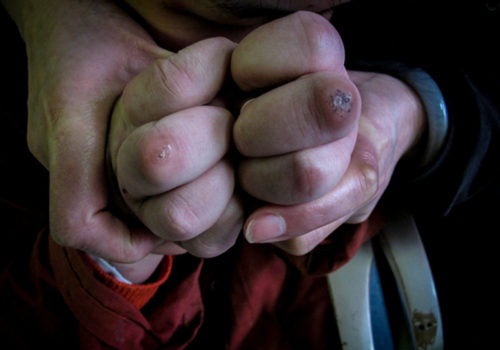Like most people in the world, I only became aware of autism thirty years ago, after the release of the 1988 film “Rain Man”, which won four Oscars. Today, April 2 is World Autism Awareness Day, which was instituted by the United Nations in 2007. In Shanghai, photographer Zheng Min’s exhibition opens in the Himalayan Museum, an unmissable opportunity to get a closer look at the daily life of the parents and children who suffer from autism. In France autism was officially recognized as a disability only in 1996. And the whole month of April is Autism Awareness Month: that is the reason-why I wanted to share these unpublished photographs by Zheng Min on this platform.
Autism today is still poorly understood, hence the puzzle ribbon used as the symbol of autism. Seven years ago, Zheng Min, a photographer working for Shanghai Television, was coincidentally invited to attend a meeting of parents of autistic children. As a reflex, he brought along his camera. During the afternoon tea-time that lasted over two hours, he noticed that the children sitting around a common table did not speak to each other nor look at each other. If their eyes wandered around, there was not a single sparkle in their eye. And each one of them ate his own individual dessert. One boy in particular took half an hour to eat a banana. While chatting with some parents, Zheng Min realized the unusual existence of such a community, whose children are addressed with the epithet of “Stellar Children”, “because” Zheng Min explained to me, “they are like extraterrestrials with whom humans have no way to communicate”. From then on, Zheng Min took part regularly in the activities of this “Rainbow” Association, taking more and more pictures, that he would later bring to them as souvenir. These photos sometimes moved the parents to tears because they were a vision by someone who looked in from outside of the mother-child cell, an inseparable cell and yet blocked by an insurmountable barrier. That’s how he became a familiar figure accepted as one of their own.
One day Zheng Min was told that one of the children had a very serious meltdown. So he rushed to her house with his camera, that was the beginning of his seven-year documenting the ups and downs of Feifei, and the ordeal of her mother. Feifei, who was barely 20 years old at that time, stayed cloistered all day at home, she could not take care of herself and had tendencies to harm herself. She went from blow-ups to meltdowns. She even underwent brain surgery, after which there was a period of improvement, but then again relapse. Feifei’s mother confided her distress and despair: “I have no hope, I see no future, some days I think I just want to jump out of the window with her.” These are the most dramatic images of the entire series of more than 100,000 shots accumulated by Zheng Min in seven years. Feifei with a battered face after she banged her head repeatedly against the wall, close-ups of makeshift camisoles to restrain her, handcuffs to tie her to bed, and her gaze that spoke an incomprehensible language when her mother was about to leave her in the hospital. Or her eye turned sideways when her mother dangled a little blue furry doll before her…
Why are photographers so attracted by psychiatric wards, by the blind and the physically and mentally handicapped? I have often asked myself this question having in mind Antonin Artaud’s frightening portraits. Well, not all persons with autism are geniuses, or can memorize all the airlines with or without accident, or know how to count blackjack cards in casinos. Among Zheng Mins portraits of the stellar children, there is this 19-year-old big boy who could not stop drinking water and going to the bathroom all the time, or that kid who could not take his meals in the presence of his mother, she had to hide away on the balcony and kept watch behind the curtain. Perhaps they are not aware of reality, or cannot come in contact with reality. Photography is supposed to grasp the reality; in Japanese the word photography is translated as SHASHIN: writing the reality. This is the paradox of photographing autism, have we really succeeded in penetrating inside the mystery? Inside the puzzle? Can the camera explore the depths of the autistic child’s soul? Or do we know how the autistic see us? That is all the merit of the photographer to attempt to enter into the soul of the autistic, but still it remains an attempt. It is indeed true documentary work, a perfect set of concerned photography, it starts with first of all by being concerned.
Jean Loh
Jean Loh is an author specializing in photography based in Shanghai, China.
Zheng Min, Autism
2 April to 30 April 2017
Shanghai Himalaya Museum
869 Yinghua Rd
ShiJi GongYuan, Pudong Xinqu
Shanghai Shi
Chine
















